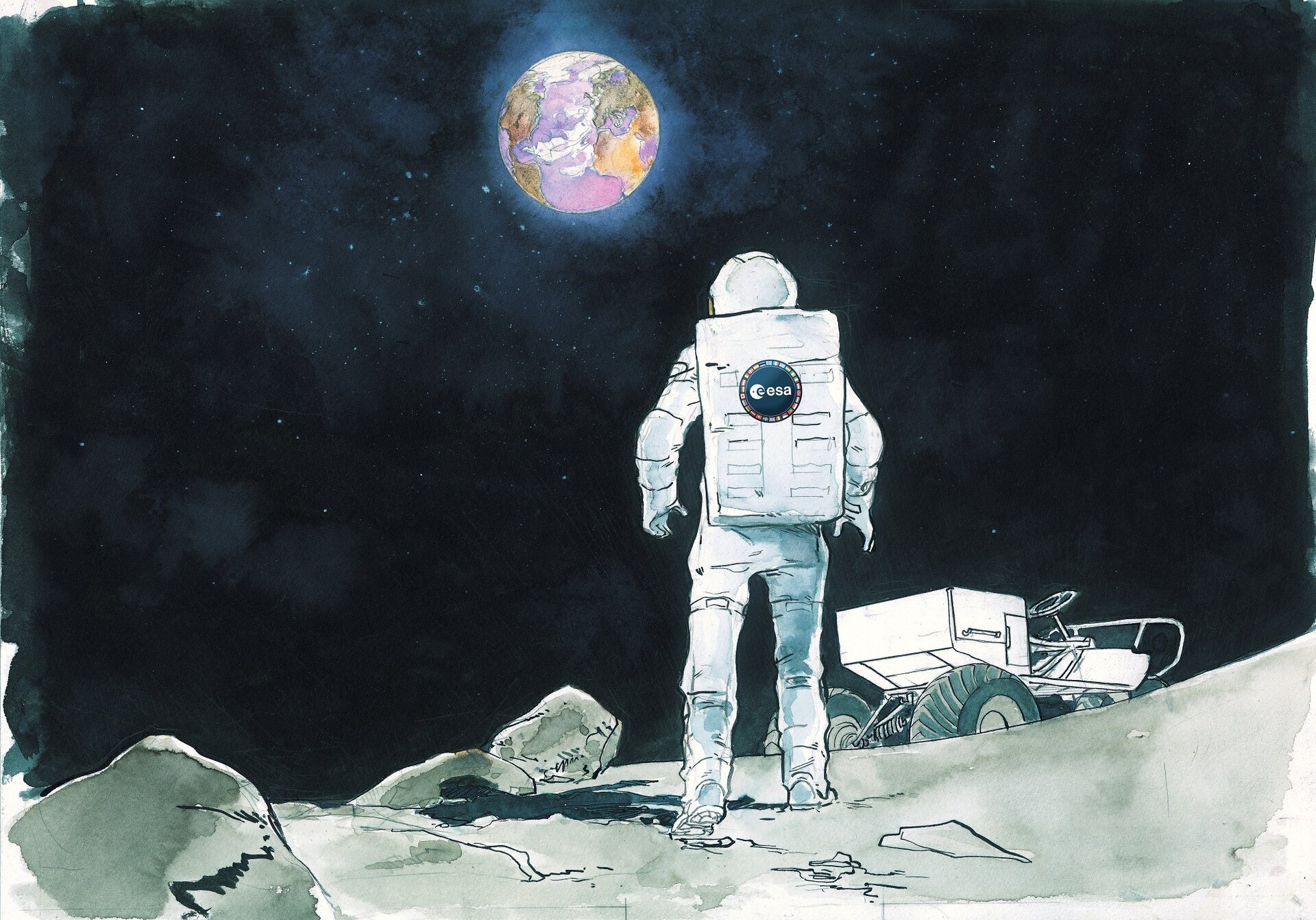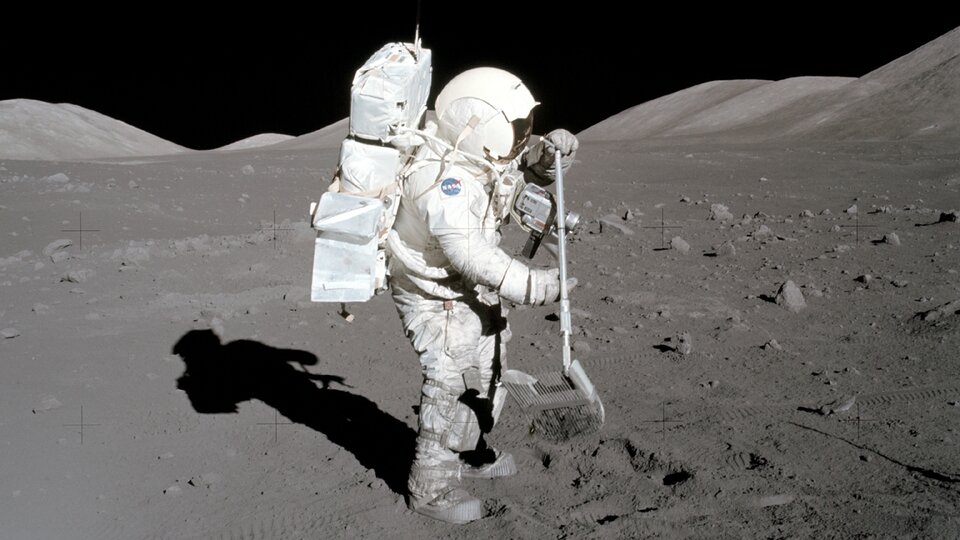6.02.2023

In brief
ESA is calling creative minds to envision what a European spacesuit should look like. How could we visually design a spacewalk suit to be instantly recognisable as European? What should ESA’s branding look like in the next decades as our next generations of astronauts walk on the Moon, Mars and beyond?
In-depth
As humankind’s technology becomes more advanced, and the possibilities for human space travel are realised, it is important to think about what types of conditions we may encounter on the surfaces of other worlds and prepare for them.
Protection from the space elements

In the coming decades, ESA is planning not only to go to the Moon and Mars, but possibly beyond. When we land on the surface of other planets, it is important for astronauts to have spacesuits that can help them withstand the harsh conditions thrust upon them by alien environments.
These harsh conditions include extreme temperatures, radiation, high-speed debris and dust. Places such as our Moon have nights that last as long as 14 days, dropping temperatures to –170°C. The Moon has no magnetic field so cosmic radiation passes through the thin lunar atmosphere uncontested, exposing astronauts to dangerous levels of radiation. This applies to Mars as well, where days and nights are cold, and radiation can kill without proper protection.
A spacesuit must serve as a life support system that will enable cosmic explorers to safely navigate their surroundings. Destinations like the Moon and Mars will be unforgiving to ill-equipped astronauts.
Since humankind’s first visit to the Moon, the universal standard for astronauts has been NASA’s extravehicular activity (EVA) suit. This suit has been front and centre of virtually all iconic astronaut imagery that has ever been released. As we look to the future, it is time to think about the evolution of this life-support device and how it will frame and protect astronauts in the future.
Spacesuit looks

ESA is holding a spacesuit design competition to allow those interested in Europe’s future in space to have their say on what it might look like, visually. The spacesuit must include essential design elements of course, such as a backpack with life support systems, a visor to see through in varying lighting conditions, and it must be a realistic, so bulky, pressurised suit. Designers do not have to worry about technical specifications as this is a visual design competition. Other elements to include are a flag with the astronaut’s nationality, a minimum of seven different layers of materials and an interface for the life support system.
You have until 28 February to submit their design. A jury consisting of design and EVA experts and an astronaut trainer will determine the most suitable designs. The designers of the five best proposals selected will be invited to the ESA European Astronaut Centre later this year.

Future missions will bring Europeans to the surface of the Moon and eventually to Mars and possibly beyond. Once they get there, our astronauts aren't going to spend all their time indoors. As soon as they exit their relatively safe bases to explore these new destinations, they will need protection from the extreme environments they encounter. Enter: the extra-vehicular activity (EVA) suit!
The EVA suit is one of the most emblematic features of human space exploration and acts like a mini spaceship designed to protect our astronauts from these harsh conditions. Building a functioning EVA suit is an extremely complicated endeavour and people around the world are coming together to think about the best technical way to build the future EVA suits. But what about the appearance? How can we make an EVA suit instantly recognisable as a European suit for our ESA astronauts? We want your ideas!
SPACE SUIT CRASH COURSE
A space suit is designed to enable humans to survive in the harsh environment of space. In particular, astronauts need an EVA suit for activities outside the spacecraft, for example spacewalks or exploring lunar and planetary surfaces. An EVA suit is in essence a miniature spaceship; it must provide all the same life support tools - air and water - that a spacecraft does while allowing our astronauts to safely explore these new destinations. Not only must the space suit provide life support, but it must also resist harsh conditions such as extreme temperatures, damaging radiation, high-speed debris and clogging dust.
The destinations we plan to go to are nothing like Earth. We plan to return to the Moon by 2030. Due to its rotation, the Moon has nights lasting as long as 14 Earth days, exposing astronauts to temperatures as low as -170°C degrees in the middle of the night. Also, the Moon has no magnetic field nor atmosphere; there is no air to breathe and astronauts have no protection from harsh cosmic radiation. The lunar surface is covered in sharp grey dust called regolith; the lack of wind means there is no erosion to soften the edges, therefore the dust is razor-sharp. Walking on the Moon's surface is like walking on broken glass...
"I think probably one of the most aggravating, restricting facets of lunar surface exploration is the dust and its adherence to everything no matter what kind of material, whether it be skin, suit material, metal, no matter what it be and its restrictive friction-like action to everything it gets on". Pete Conrad, Apollo 12 Commander. Image from NASA of Pete Conrad's dust-covered glove.

WHY ARE WE DOING THIS
The conditions that our astronauts will face while exploring these future destinations are very challenging; as you can see, the EVA suit is a crucial part of withstanding these conditions for the exploration process. Building a functioning EVA suit is a complex and expensive process; so while we let our experts deal with the complicated technical details, join us in envisioning how the future European EVA suit should look like!
Your design could be used by ESA in exhibitions and by the film industry, to educate and inspire people about space exploration.
WHAT WE'RE LOOKING FOR
We are looking for an EVA suit design presented in A3 format, with an accompanying text of up to 400 words explaining how your design represents European identity. The design can be digital or a scanned drawing. The submission should include a frontal, side, and back view of the suit, as seen below:

Tip: Consider some "space suit must-haves" in the image below. You do not have to worry about detailed technical aspects of the space suit design, but try to strike a balance between an inspiring visual design and something which is technically feasible in the next few decades!

WHAT HAPPENS NEXT
You have until 28th February 2023 to submit a design. Once you have submitted your proposal, it will be reviewed by our jury panel composed of design & EVA experts, including an astronaut trainer! Up to 5 of the best proposals will be selected and those who submitted them will be invited to an ESA centre later in the year (please refer to the EVA Competition Terms and Conditions for more information)!
Remember, this competition places the emphasis on the look of the space suit rather than the technical elements - anyone with an interest in space and design can participate! We look forward to seeing your ideas!
Eligibility Rules:
- You have to be 18 years or older
- You must have read our terms and conditions and the general conditions of participation to campaigns on this OSIP platform (you can find both below)
- You must be a citizen of the Member States, Associate Members and Cooperating States of the European Space Agency (see the full list here).
- ESA employees, ESA associated members and jury members are prohibited from entering the competition
Submission requirements:
- Application form must be completed on time
- Contestants can submit only 1 proposal
- Proposals have to be submitted in English
- Only original works are accepted
- Only submissions made through the application form on this OSIP website will be accepted
- Only submissions relevant to the competition and of a minimum quality will be accepted
If the conditions above are not met, the submission will be excluded.
Note: ESA have no obligation to disclose the names of jury members or provide feedback. The winners will be invited to an ESA centre on a cost-reimbursement basis (see Terms and Conditions).
Your ideas will be evaluated according to the follow evaluation criteria:
- Representation of the European identity - both visually and within the accompanying text
- Creative but realistic
- Quality of the image
- Innovative, inspiring design
Attachments
| Name | Added on | |
|---|---|---|
 |
EVA Competition Terms and Conditions_2022.pdf | Jul 21, 2022 |
 |
OSIP-Platform Terms and Conditions.pdf | Sep 7, 2022 |
Quelle: ESA
